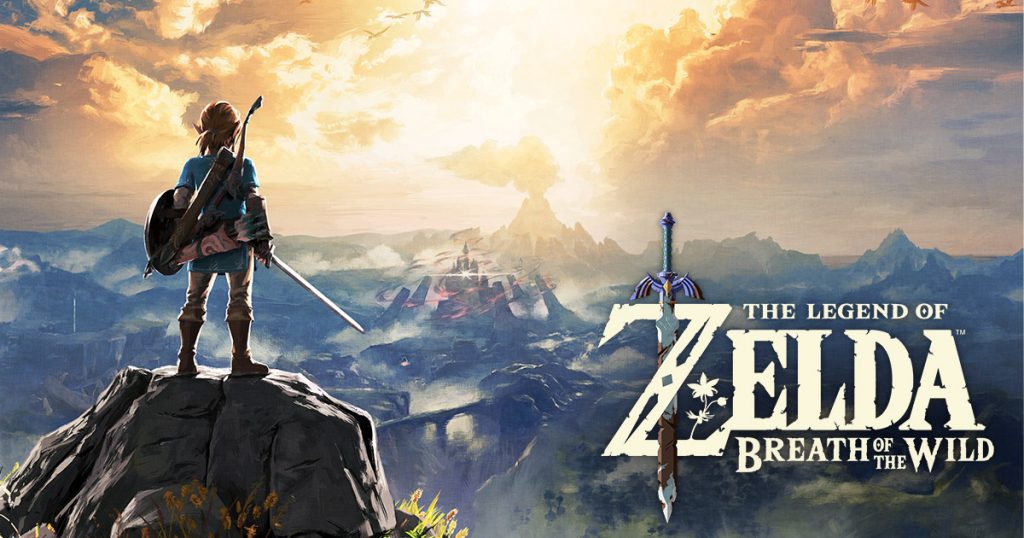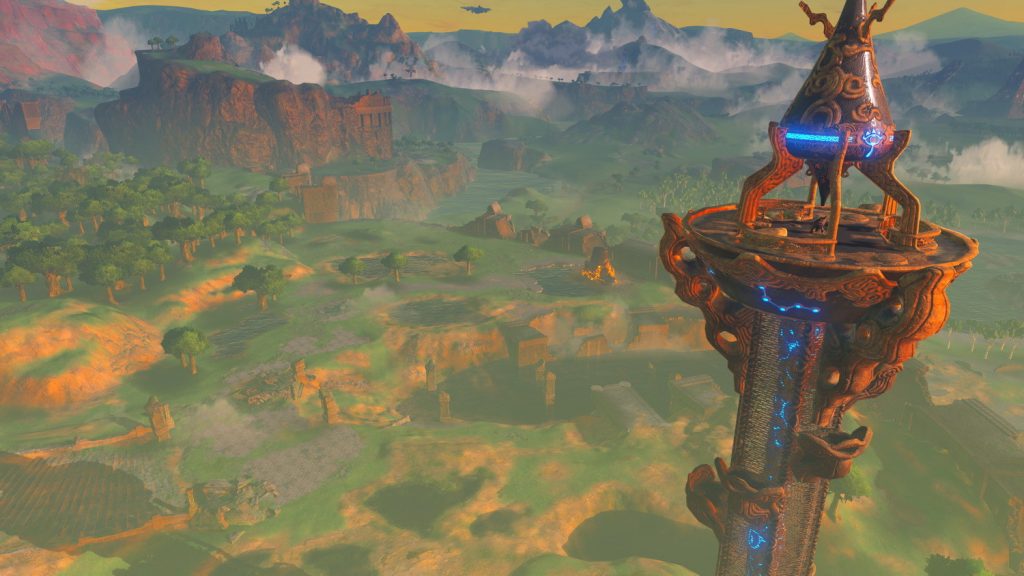
Like many whom have played the Zelda series, most all harken back to Ocarina of Time as the one that catapulted the game and broke the mold on what the series could do. While I personally still feel A Link to The Past is the best in the entire series (with a penchant for Twilight Princess coming in a close second followed by OoT), one thing is for certain; The Legend of Zelda is a series that stands the test of time. A never-ending fairy tale video game series with an immense lore and at its core a story of good versus evil, The Legend of Zelda has in fact become quite legendary indeed.
I remember first making it to the over world in Ocarina of Time and staring in awe at the vast landscape. Seeing Death Mountain off in the distance and knowing that I will eventually get there was a joyous emotion I felt way back then. Nintendo tried to emulate that over the course of its games after OoT but it never came quite close. The vast sea of Wind Waker, the gloomy over world of Twilight Princess and even the open sky of Skyward Sword never managed to capture that same feeling. It’s almost as if Nintendo was stuck in the very shadow of Death Mountain itself and could never break free from that once innovative monumental moment of gaming. Living up to its new console name and wanting to ensure that the Legend of Zelda would stay a relevant franchise, I am glad Nintendo switched it up with this release and breaks all the conventional rules of their design philosophy.
The biggest change that BotW brings is a true sense of freedom in the world it has created. If you can think it or conceive it in game, there is a high chance it can be done. I can chop down a tree and ride the log down a river bed. I can fight an enemy in a thunderstorm and let it be struck by lightning. I can take inflatable Octorock remains and attach them to said log and then climb the log and float across the field in the air. Going back to that thunderstorm moment, it was a sheer joy to use the game’s Sheikah Slate and it’s metal lifting telekinesis power to pick up a metal crate, have it get struck by lightning and utilize it as a giant electricity-infused box of doom smacking into an army of moblins. This is basically Grand Theft Hyrule, and it is incredibly fun.
The combat is something you will immediately notice has undergone the biggest change. You are given a wealth of toys to play with but the best moments shine when you are sneaking into an enemy encampment, stealing their clubs from underneath their noses and then going for the attack and watching them helplessly flee in terror as they realize they are defenseless. You’re given an infinite supply of bombs, the magnetic power and later on even an ability to charge objects with kinetic energy and fire them off like a bat hitting a baseball. This is the freedom we’ve all wanted in Zelda combat, and it’s all at the tips of your fingers in BotW.
The freedom is so heavily prevalent that series producer Eiji Aonuma stated that if you wanted to you could confront Ganon from the very beginning. I am proud to tell you that this is indeed true, but not recommended as Calamity Ganon is so damn powerful he will kill you in one hit. The key to defeating him lies in the game’s central quest line which will have you partake in the series mainstays of dungeon crawling, earning a power in said dungeon and then utilizing that power to assist you further in the game. Now while there are only around 5 or 6 main dungeon type ordeals to contend with in the game, the true joy is in searching for and finding the game’s hidden shrines and enemy outposts and other secrets that all net you some sort of reward, be it story, an item or just some background lore. Every inch of Hyrule is explorable in this game and should you have the tools its vast landscape is yours to explore. The size and things to do put many other open world games to shame. It is also helpful that Nintendo has peppered a lot to do while you explore, blending set-piece action segment into explorative sandbox with seamless effort. It is great to see that Nintendo and the Zelda franchise has done away with the hand holding of its predecessors, and is more in line with true freedom of gameplay.
Being able to tackle any of your destinations in any order is a welcome change. If you were to simply focus on the main quest, you’d honestly only see less than half of what the game has to offer. It is in pushing towards the unknown that Breath of the Wild unveils its true skin and allows you to forge your own tale on how you approach the final encounter. Think along the lines of games like Skyrim or Metal Gear Solid V: The Phantom Pain in terms of that freedom and then give it a Nintendo coat of paint and you essentially have Breath of the Wild. This is the Zelda team’s first true open world and they have included so much. A tropical paradise lies hidden behind barren cliffs. A giant-sized beast lays dead in the field and you can explore its ribcage and fight off the enemies who have taken up camp in it. Towering architecture begs to be explored off in the distance and often leads to several of the game’s Shrines that contain a few rooms of dungeon puzzling.

All this exploration is aided by Link’s new ability to climb almost every surface in the game. Every cliff you see can be scaled and it often leads to wonderments of discovery. You’ll want to paraglide everywhere after getting to the top of a mountain or cliff side, praying it doesn’t suddenly rain as you make your way upward so that the surfaces aren’t slippery and you don’t fall to your doom. Another benefit to this exploration is what I believe to be a side quest of sorts. Hidden throughout the land are the Koroks, the forest children you might remember from Wind Waker. Finding one nets you some lore, sometimes items and all leave you with a wonderful view of the land. It’s those little things I enjoy about open world games that many nowadays don’t do, so it is refreshing to see that BotW has it in spades and actually makes it worth your time.
On top of the incredible changes to exploration, the game also does some tweaking with its RPG components. Your stats are now defined by your equipment, so you are as strong as whatever it is you can carry. Your weapons have durability now as well, so careful organization of what you carry is essential, and smart use of the many weapons you come across will ensure your favorite weapon type remains at the ready. Another fantastic change is the ability to concoct your own food mixes and elixirs that give you certain stat boosts. Some foods give you extra stamina or extra hearts. Creating a warming elixir before exploring a snow covered landscape will keep you warm as you search for clothing that negate the slow life drain of the icy cold on your health meter. I’d normally be annoyed at this kind of thing in other games but Nintendo manages to make it so easy and fine tune it that it doesn’t even feel that tedious to do, and the benefits last a good while that you don’t need to worry too much to create another soup or elixir for a good bit of exploration. You’ll even find weapons that are more durable than others and come in the forms of clubs, swords, spears and even the traditional boomerang. All wear down after a bit, but when you find that well rolled stat one, the game makes you want to conserve it for as long as possible, saving it for when a more difficult encounter warrants its use.
If Breath of the Wild has any major achievement within it, it is that it has taken a genre that is more often than not flawed by huge ambition and poor execution. It’s almost like Nintendo spent the last two console iterations studying what makes it work and what doesn’t, and decided to toss in what made Zelda work and removed what didn’t work to create what is easily the best entry into the series to date. It’s not perfect of course, but one can only nitpick about minor drops in framerate before you realize that the sheer scale and size of this game definitely came at some cost.
It matters not though, as Breath of the Wild refreshingly brings back a glorious sense of nostalgia and adventure. The Legend of Zelda series has always been the best fairytale and fantasy achievement of gaming since the glory days of the NES. Immense and grand landscapes as far as the eye can see, Hyrule Field sprawled out before you and you smile as the sun rises across the water and the whimsical piano theme chimes into your ear, occasionally dipping into that original theme we all know and love. It is the nostalgia that Nintendo is so keen to throw in all of its games that works so well in this. The merging of the Zelda games of old with the nuances and styling of today’s open world games is an incredibly smart choice by Nintendo to grow this franchise up in a way. By carefully selecting what worked in the previous games and combining it with what is successful in the open world genre, Breath of the Wild effectively switches both the Zelda series and open world genre on their head. It allows it to extend its grasp and not just be one of the best games in the series, but I would dare say it lets it be quite possibly one of the greatest games ever made.









